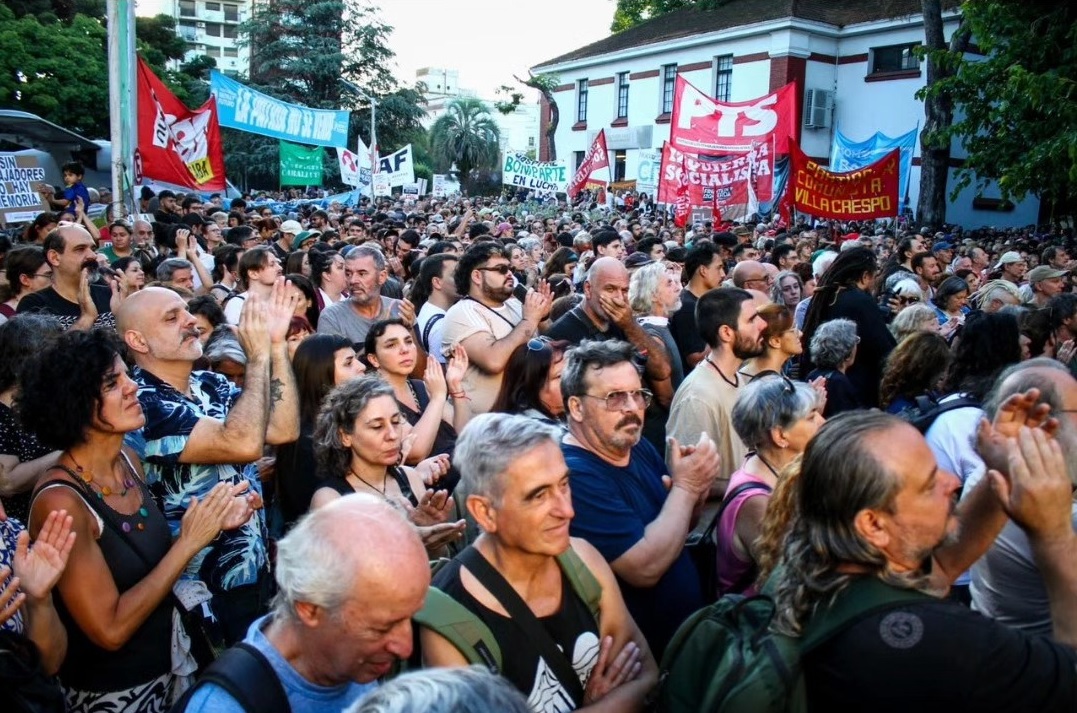
The current government’s policy on human rights has raised alarm bells in various sectors of Argentine society. The recent episodes of impunity towards convicted genocidaires, together with the attacks on the institutions and workers in charge of preserving historical memory, paint a worrying picture.
One button is enough to show
Alejandro Domingo D’Agostino, who drove the plane from which the Mothers of Plaza de Mayo, the French nuns and other relatives and human rights activists were thrown into the river, walks around with impunity. Last year, the repressor violated his house arrest more than ten times, leaving without authorization. However, in response to the request to revoke the domiciliary status, the first oral court and now Cassation allowed him to maintain the “domiciliary status.”
The murder of the twelve of Santa Cruz – as the massacre is known –, among whom were the Mothers Azucena Villaflor, María Ponce and Esther Ballestrino de Careaga and the nuns Léonie Duquet and Alice Domon, was due to the fact that they met during the dictatorship. military to organize actions to claim the whereabouts of their loved ones, kidnapped and missing. It was possible thanks to the tip of an insider. The same one who organized “the visit to Ezeiza” a few months ago, the Navy genocide Alfredo Astiz. The government delegation that went to the prison with the intention of advancing with the impunity of the genocidaires believed that they were going to be applauded, that they would become heroes, and they ended up rejected and repudiated.
In her testimony, the tireless Mother of Plaza de Mayo Nora Cortinas told, in the context of the trial for the ESMA case, in 2010, how “Around June or July 1977, a young man appeared who would be the age of our children, handsome and very sportsman, said that he was the brother of a missing person and wanted to bring us his testimony. He walked in the middle of us, grabbed our arms, and we were very naive…”
A regular attack on human rights: without workers there is no memory
While D’Agostino received a Christmas gift, Javier Milei’s government has been intensifying its offensive against historical memory and human rights in Argentina. A package of measures that favor the impunity of the repressors, massive dismissals in the Secretariat dependent on the Ministry of Justice and the drastic reduction of the staff’s salary, the emptying of memory spaces and the permanence of judicial benefits for convicted repressors.
It is about the loss in the Ministry of Justice of more than 2,400 jobs and families on the street and a 50% reduction in salary, the almost complete dismantling of the Human Rights Secretariat and areas such as memory and work spaces specific to crimes against humanity.
Taking advantage of the precarious hiring of its workers, as well as the payment of half a salary to the permanent and temporary plant, which the different procedures have been applying since the 1980s, through the Cooperating Entity Association of Automotive Dealers of the Argentine Republic (ACARA ), the government ordered its closure. That is, open or covert dismissal, since this is how the salary reduction is considered as it is an acquired right. It pursues the same purposes as the freezing of state salaries in general, only in an extreme way. Economically suffocate your workers and cause resignation or double employment.
The massive dismissals strongly affected plaintiff lawyers in trials against humanity, leaving provinces without representation and putting cases at risk. Because the Federal Justice system respects the accusatory principle: if the prosecution does not accuse, there are no convictions. The Córdoba Human Rights Table, for example, denounced that, “with the dismissal of the lawyers who filed the complaints, these cases will now remain, for the most part, without sponsorship.”
The government seeks to sweep away the results of years of democratic struggle in Argentina, attacking an emblematic place for human rights. It seeks to advance with impunity and embolden repressive forces, in general, as we recently witnessed with the brutal murder of Fernando Gómez in Salta by the National Gendarmerie. With repression, demagogic policies of workers against workers and agreements with caste, the government hopes to achieve a historic leap for the benefit of big businessmen and the IMF. But the actions in which thousands and thousands of workers and young people participated to prevent the Milei attack speak volumes.
From the military dictatorship, through the ’90s to the present: the resistance is in the streets
In a few days, two massive events – the Embrace of ESMA and the Festival last Saturday – showed not only that strength exists, but also that we are not starting from scratch and we have an experience that involved different generations for decades. They showed the possibility of building a resistance with the participation of the Secretariat workers together with the immense solidarity of political, social and union organizations, neighborhood assemblies and student centers that gathered.
Let us think that the great democratic movement of our country – recognized worldwide – emerged from the courage of a handful of mothers gathered in Plaza de Mayo in the midst of the dictatorship. And it expanded more and more throughout the 1980s and 1990s. Workers and students, professionals, cultural sectors and democratic and left-wing organizations formed a broad democratic movement that fought in the streets and achieved mass repudiation of the state repression and impunity of yesterday and today. The festival represented a confluence between these sectors and thousands of young people, many of whom came from fighting against the chainsaw plans in education and now accompany the fight against the advance of impunity and repression.
But they merit the questions of Ciro Annicchiarico, a Secretariat worker, member of a team of lawyers who carried out trials for crimes against humanity. “What are our political colleagues who make up the national and popular camp doing? What place are they occupying in the face of the defection of the union leaders…? What are all our deputies and senators doing, apart from dedicating themselves to taking over spaces and places in the ready for the next elections?”… It seems that they are still the same, they intend to transform acts of struggle into electoral ones. Even after the Festival they refused to call a single assembly of the entire Human Rights Secretariat. Divide and rule.
Myriam Bregman’s words in Abrazo a la Esma were conclusive: “the lesson we learned is that if grandmothers continue to find grandchildren after so many years, it is because they never gave up that fight. So what are they going to talk to us about right-wingers, what are they going to talk to us about the fascist government, a lot has happened here. What is important is the unity of the workers, who democratically organize themselves, who fight it in each workplace, who demand a plan of struggle so that this struggle is not lost…. What is most important is that You have to build that resistance. Because the resistance against this government…is built by putting in the body. It is built while in the streets. It is built by being on par with you, it will not leave any social network.”
The need for a great front of struggle that begins by surrounding the workers with solidarity, the call for national and international support of the fight for human rights in Argentina and organizing the resistance, in a democratic way with all the sectors that have already said present at the Festival, is the task of the moment.
Source: www.laizquierdadiario.com

